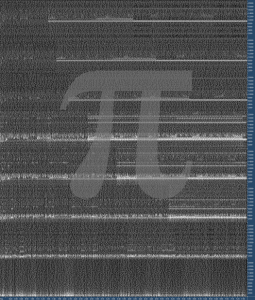Approximating π (2007)
A Sound Installation
Construction Method
Point of departure: the converging series π = 4 – 4/3 + 4/5 – 4/7 + 4/9 ∙∙∙
Each convergence gets a time window of 5040 samples (double the LCM of the numbers 1 to 10), in which ten square wave partials of frequencies 8¾n Hz and amplitude 2^dn are set up, ‘8¾’ deriving from the 5040 samples, ‘n’ being the partial number and ‘dn’ the nth digit in the convergence’s decimal representation; e.g. for ‘3.141592654’, the ten partials’ amplitudes are 23, 21, 24, 21 ,25, 29 etc., thereafter rescaled by the arbitrary sawtooth spectral factor 2π/n, where ‘n’ is still the partial number. The convergences make the digits stabilize from left to right to a value approaching π, the resultant timbre moving from turbulence to constancy over 4 x 109 x 5040 = 20.16 x 1012 samples or ~14½ years. The installation can be pitch-transposed (by sample dropping) and/or time-truncated. Here the eight sound channels are transposed from 8¾ Hz to frequencies 9, 28, 50, 72, 96, 123, 149 and 175 times higher (= [9 x π(1+½+⅓+ ∙∙ +⅟χ))], χ being the channel number plus one); the duration is truncated to a millionth of the total, i.e. 7′ 37″, the highest transposition thereby reaching the 700,000th approximation of π, where the first six digits are already stable.
Clarence Barlow (1945): born into the English-speaking minority of Calcutta, going there to school and college, studying piano, music theory and natural sciences. 1957: first compositions. 1965: graduated in science at Calcutta University, thereafter active as conductor and music theory teacher at the Calcutta School of Music. 1968: moved to Cologne, studying (until 1973) composition and electronic music at Cologne Music University. 1971-1972: studied also at the Institute of Sonology, Utrecht University. 1971: began to use computers as a compositional aid. 1982: initiated, 1986 co-founded, 1986-1993 and 1996-2002 chaired GIMIK: Initiative Musik und Informatik Köln. 1982-1994: in charge of Computer Music at the Darmstadt Summer Courses for New Music. 1984-2005: lecturer on Computer Music, Cologne Music University. 1988: Director of Music, XIVth International Computer Music Conference, held in Cologne. 1990-1991: visiting professor of composition, Folkwang University Essen. 1990-94: Artistic Director, Institute of Sonology, Royal Conservatory, The Hague. 1994-2006: Professor of Composition and Sonology at the same conservatory. 1994-2010: member of the Académie Internationale de Musique Electroacoustique in Bourges. 2005-2006: visiting professor of composition, School of Music and Performing Arts ESMAE in Porto. Since 2006: Corwin Professor and Head of Composition, Music Department, University of California Santa Barbara; concurrently also Affiliate Professor, Media Arts and Technology as well as College of Creative Studies, UCSB. www.rlow.org/
